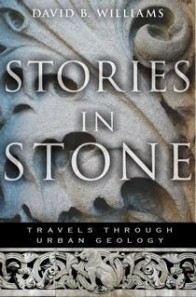Book Blogging: Stories in Stone #1 — A Review
Note: This post is the first of two about Stories in Stone and summarizes my thoughts about the book. The second post, which includes a Q&A with David B. Williams, the author of Stories in Stone, is here.
Have you ever looked at a particularly beautiful polished granite in the foundation of an office building and wondered where it came from and how old it was? Or, have you ever walked down a city sidewalk and noticed that the sidewalk was made of slabs of sandstone instead of boring concrete?
Instead of a sweeping landscape or a detailed view of sedimentary structures, my Friday Field photo from a few days ago was of houses in Brooklyn, NY. A busy street in a densely populated city is not what most of us picture when we think of “the field”. But, building stone was once part of the geological record — and it has a story to tell.
 Stories in Stone: Travels Through Urban Geology by David B. Williams, published just a couple months ago (June 2009), tells those stories.
Stories in Stone: Travels Through Urban Geology by David B. Williams, published just a couple months ago (June 2009), tells those stories.
Geologists will certainly enjoy this book, but Stories in Stone is not a book about just geology. In fact, while I found learning about the geologic origins of building stone enjoyable, my favorite aspect of the book is how the geology is combined with the historical and cultural stories.
For example, the first chapter is about the reddish-brown sandstones that were used to build the beautiful brownstone buildings in New York City. Much of the building stone came from the Triassic-Jurassic Portland Formation (Newark Supergroup), which, as the following excerpt explains, was related to sedimentation in rift basins:
At least fifteen rift valleys, or basins, opened as North America, Africa, and South America pulled away from one another. The individual basins stretched from Alabama to the Bay of Fundy. Streams from adjacent hills and mountains began to carry sand and silt into the basins, including one where the Connecticut River now flows …
In addition to discussing the tectonic context of these depositional systems, Stories in Stone zooms in and talks about what turned out to be very important trace fossils in these rocks:
Nowhere on the East Coast is the record of dinosaur ascendancy better recorded than in the fifteen thousand feet of sediments that accumulated in the Connecticut River Valley. … The warm and well-watered valley was ideal habitat for dinosaurs. As they tromped around in the moist mud and sand along the valley’s streams and lakes, the great and the small left behind thousands and thousands of footprints, which remained intact as the mud hardened into rock. These tracks are one of the coolest and also most geologically important aspects of the brownstone.
Stories in Stone is chock full of fascinating geologic tidbits like this. But, as I mentioned above, how the geology is intercalated with the architectural and engineering aspects of building stone is really what this book is about and why it is a good read. For example, here’s another passage about the brownstones:
Bedding created a flat surface ideal for building blocks. Quarrymen also took advantage of bedding because the contact zone between beds is weak — relative to surrounding rocks — and is easier to pry apart. Furthermore, floods often deposited nearly pure beds of the same-sized sediments, which made the Portland rocks homogenous and easy to work with.
This book will certainly open the eyes of non-geologists to think about where building stone comes from — and, for practicing geologists, it may have a similar, but opposite, effect. That is, when I’m in the field observing and documenting the nature of bedding I may now wonder what kind of bedding contacts are optimal for making building stone! Very cool. This is what I look for in books like this — something that makes me think differently about the world around me.
The excerpts above are from the first chapter of this book, about the brownstones, which I chose because I’m a clastic sedimentary geologist. But Stories in Stone includes an incredibly diverse selection, geologically speaking, of building stone stories. In other words, it has something for everybody:
- granite (Boston and Carmel, CA)
- gneiss (Minnesota)
- coquina (Florida) — this is probably my second favorite chapter after the brownstones … you’ll learn why coquina is extremely good at defending against 18th century cannonball fire
- limestone (Indiana)
- petrified wood (Colorado) — yes, there is a building made out of petrified wood
- marble (Italy)
- slate (East Coast U.S.)
- travertine (Italy)
I’ll end my post with this passage, which is in the concluding chapter about travertine, but I think it applies well to all building stone:
People further relate to rock as a building material because they intuitively sense the link between stone and earth around them. Even if they can’t tell the difference between granite and marble, they know that building stone has a history and a story. No manufactured building material can provide the deep connection to place that stone does.
So, if you aren’t a geologist and have ever wondered about the geological stories behind building stone you will thoroughly enjoy this book. If you are a geologist (which most of my readers are) you will enjoy Stories in Stone because it very eloquently weaves fundamental geology into a larger fabric of architecture, history, and culture.
–
To learn more about this book, check out this post for a Q&A with the author David B. Williams.